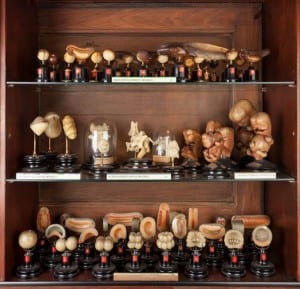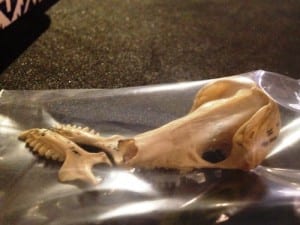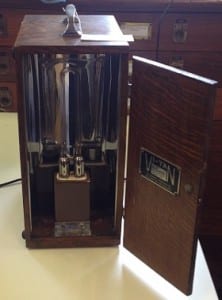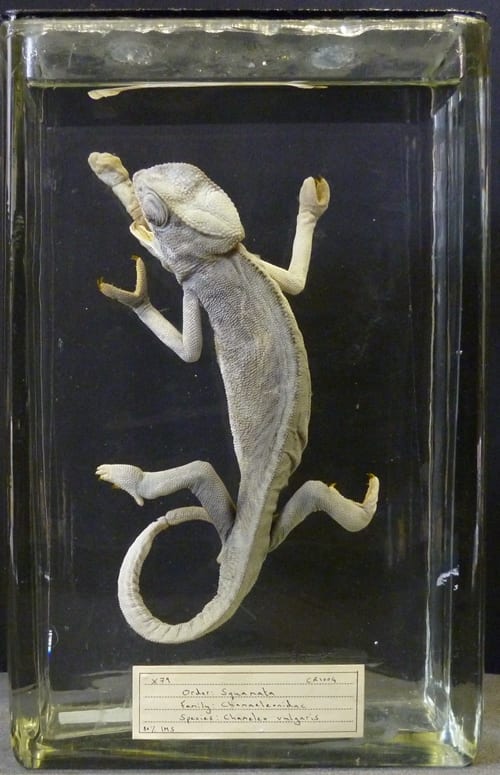The Mystery of the Giant Golden Mole Skull
By zcbtekp, on 16 February 2016
Crawling blindly through tunnels under layers of dead leaves in the coastal forests of South Africa lives the giant golden mole. Most people don’t know it is there, and neither did I until I was presented with the skull of one this October. As this species lives exclusively in a tiny region on the Eastern Cape – most people have definitely never seen one! Who would have guessed that identifying this skull would be the start of my newfound love for these unlikely animals. Read the rest of this entry »
The terror, the terror!
By Jenny M Wedgbury, on 15 February 2016
On 26 January UCL Art Museum hosted a Pop-Up display dedicated to the theme of the French Revolution. This ties in with our current exhibition, Revolution under a King: French Prints 1798-92. As part of our ongoing wish to support UCL students and alumni, the exhibition was curated by volunteers Viktoria Espelund, Shijia Yu and Rosa Rubner. They each chose French Revolutionary prints from our collection and approached the topic from unique perspectives. The rationale behind their selections can be seen below.
Animal Facts to Fall in Love With…
By tcrnrh1, on 12 February 2016
In anticipation of Valentine’s at the Grant this Friday (12th February) I have sought out some animal facts which you will otterly love! On Friday the museum will be holding a themed late opening with Valentine’s-related animal tags being placed around the museum. Please excuse the Valentine’s puns – I’ve had a whale of a time writing this!
Please don’t call us a Cabinet of Curiosity
By Jack Ashby, on 12 February 2016

Embryological wax model display at the Grant Museum.
Top: Frogs; Middle: Arthropod, Echinoderm, Human; Bottom: Lancelet
“Isn’t the Grant Museum wonderful! It’s such a cabinet of curiosity!”
This exclamation is clearly meant as a rich endorsement of the Grant Museum – it’s obviously intended as a compliment. Nevertheless, it makes me wince.
Inspiring curiosity and wonder is surely among the highest ambitions a museum could ever have. It’s infinitely more important than making visitors learn something. Curiosity? I am a huge fan. Cabinets? We definitely have some nice ones. Cabinets of Curiosity? No thanks.
For me, this term implies that our objects are nothing but curios – weird artefacts amassed by some eccentric collector. Erratically accumulated in another time; weird and wonderful titbits intended to impress; to show off the collector’s status and influence – “Gosh, Sir William! Where did you get that ghastly tenrec!?” Read the rest of this entry »
Happily Never After: A Moral Proposition for the Management of Museum Collections
By Subhadra Das, on 11 February 2016
This is a provocation I wrote and presented at ‘The Future of Museums’ Conference, held at UCL in 2014. Having attended a few seminars and conferences in the sector recently, I feel the need to share it with a wider audience. The text appears as I presented it at the conference, with added links for your delectation and miniscule adjustments to diction and syntax to make me sound cleverer.
Hello.
My provocation was: “In the future, no object should ever enter a museum collection on the assumption that it will be there forever.” Looking back, that’s pretty tame. What I meant to tell you was that, if I ever get round to writing one, my ideal Collections Development Policy would consist of just 5 words:
“Burn it. Burn it all.”
Specimen of the Week 226: Preserved neonatal rat group
By Tannis Davidson, on 8 February 2016
Last year, the Grant Museum undertook a major conservation project, Bone Idols: Protecting our iconic skeletons, in which 39 of our rarest and most significant skeletons were cleaned, repaired and remounted.
This year the focus will be on our fluid specimens. The Grant Museum has roughly 6000 preserved specimens is varying states of condition. Over the course of the next 12 months, the most ‘in need’ specimens will be rehydrated, remounted, cleaned and put in new jars (if needed). One of the newly-conserved wetties is a much-improved specimen which has generated quite a buzz around the Museum lately…this week’s Specimen of the Week is…
Look Again…UV Been Mistaken: A Case of Collection Mis-labelling
By Nick J Booth, on 4 February 2016
This is a guest blog by Felicity Winkley, one of the student engagers who work with UCL Museums. To find out more about the student engagers project please visit their website.
Last term, the UCL Student Engagers used objects from across the UCL collections to curate a six week exhibition at the North Lodge, called Stress: Approaches to the First World War.
The project, as we’ve discussed previously on our own blog, was an interdisciplinary, co-curated effort, approaching the topic of the First World War through four interpretive themes: physical stress, mental stress, cultural or societal stress, and stress on the landscape.
One of the objects we chose to highlight the mental stresses caused by the conflict and, by association, the improvements in the way mental health was approached by the end of the war, was a ‘strobe machine’. As part of the physiology collections, catalogued alongside objects like an auditory acuity tester and a set of keys for tapping multiple-choice responses, it was assumed that this light had similarly been used in psychiatric experiments to test participant responses. From our point of view, it also helped that it looked good.
For several weeks of the exhibition’s run, the object was a successful talking point. Read the rest of this entry »
Behind the Scenes of the Cabinet
By ucwehpi, on 2 February 2016
In our continuing series to document the process behind the next exhibition in the Octagon, artists Mark Peter Wright and Helena Hunter who were chosen to work with curators and academic researchers from UCL led by Helen Pike, Public Programmer at The Petrie Museum give an update on their methodology. Mark is an artist and researcher working across sound, video, assemblage and performance and Helena’s practice spans performance, text and moving image. The blog offers a chance for ideas to be presented and hopefully engage comment and conversation!
Over the last couple of months we have been developing a concept and method for material display entitled The Cabinets of Consequence for the forthcoming new Octagon exhibition. This is a reference and adaptation of the ‘Cabinet of Curiosities’. Originating from a 17th century European tradition, cabinets of curiosity were ramshackle rooms furnished with an abundance of objects of artistry, craftsmanship and relics. Wunderkammers as they were called, productively disturb taxonomic conventions of display, however, the emphasis on curiosity detaches objects from their ethical and social-political contexts.
We want to destabilize hierarchies of display but not at the expense of the entangled geo-political histories of archives and processes of asymmetrical extraction on which objects have been collected.
We intend therefore, to emphasize the multiple ecologies (Guattari, 2000) around such materials. The central challenge for us is to hold onto the vibrant materiality of objects, whilst simultaneously projecting matter into its ethico-political milieu: an aesthetics of display that not only works backwards through history, but also forwards, through the present and its possible futures.
‘A new metaphysics (materialism) is not restricted to a here and now, nor does it merely project an image of the future for us. It announces what we may call a “new tradition,” which simultaneously gives us a past, a present, and a future.’ Dolphijn, R & Van der Tuin, I.
UCL students identify mystery specimens in the Grant Museum
By Jack Ashby, on 2 February 2016
 Have you ever seen something in a museum and suspect that the curators have got it wrong? If so, I hope you haven’t been too shy to let the museum know. Speaking for the Grant Musuem at least, we love it when visitors add to our knowledge of the collection, and we don’t ask for “expert” credentials before hearing an opinion. Indeed, a 11 year boy spotted that a specimen labelled “marine iguana” was in fact a tuatara (a lizard-shaped reptile from New Zealand (that is in fact not a lizard)). And couple of years back, a visitor noticed that our famous anaconda skeleton was in fact an African rock python. Some museums might be embarrassed by the idea that some of their objects have been mis-identified, but not us.
Have you ever seen something in a museum and suspect that the curators have got it wrong? If so, I hope you haven’t been too shy to let the museum know. Speaking for the Grant Musuem at least, we love it when visitors add to our knowledge of the collection, and we don’t ask for “expert” credentials before hearing an opinion. Indeed, a 11 year boy spotted that a specimen labelled “marine iguana” was in fact a tuatara (a lizard-shaped reptile from New Zealand (that is in fact not a lizard)). And couple of years back, a visitor noticed that our famous anaconda skeleton was in fact an African rock python. Some museums might be embarrassed by the idea that some of their objects have been mis-identified, but not us.
In fact every year we give our UCL bioscience students the chance to challenge our identification as part of the fantastic “Vertebrate Life and Evolution” module. We have just created a display of “mystery specimens” identified by these students.
Specimen of the Week 225: The preserved Chameleon
By ycrnsmk, on 1 February 2016
“Karma Karma Karma Karma Karma Chameleon”
The English band, Culture Club said almost everything one needs to know about this week’s Specimen of the Week with their 1983 hit single “Karma Chameleon”.
Using the wise words of the Culture Club to guide us, we will embark on a journey of discovery and come to find that this reptile group, containing approximately 180 different types is anything but common. That said, this week’ Specimen of the Week is……….
 Close
Close







